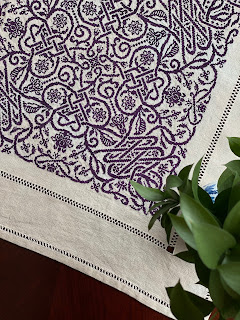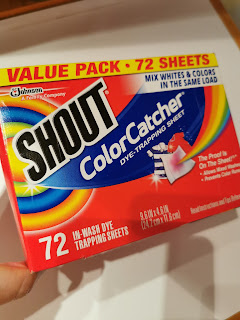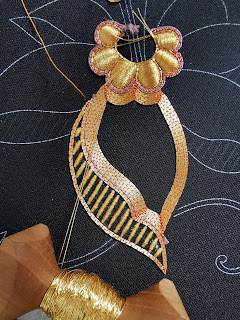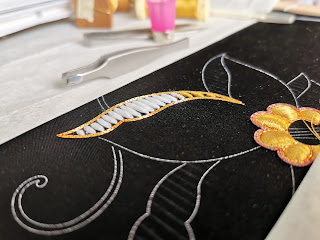This is really a finish and disaster all wrapped in one. I completed the stitching on Bramble and the Rose about a week and a half ago. As this piece has been ongoing for almost 8 years and has been everywhere, it needed to be washed. I was also hoping to get the streaks of purple out from the water bottle accident in 2019.
I did the usual cold water bath with some liquid dove soap (it was the softest I could found at the shops near me). The lines of purple didn't come out so I took the loss and rolled it up in a paper towel to dry.
I like to iron my pieces while they are still a little damp, so about three hours later I unroll the piece and find this disaster.
It immediately went right back into a cold water bath to soak and stayed there for three days. I was obviously in a panic and went to
Instagram for advice.
There were many solutions suggested, the one that came back a lot was using a color catcher. I did end up purchasing a box and trying it out, but it didn't change color. By the time I received it, the fabric had been soaking for three days, with a refresh every few hours. There was nothing left to catch but it was good to know 100% that there was no more excess dye.
I did a lot of research on my end as well, on how to save embroidery that's bled and the ice water bath seems to be the best one. You can read more on it
here. The most important thing is to be patient and not iron the piece. Once it's ironed, the colors will set and you can't get it out. The soaking process could take weeks. Proof, the little streaks of purple I was willing to leave
are now gone because the piece was soaked the time it needed.
A bit more information on the threads I used. It's a cotton overdyed thread by
Threadworx. I purchased and started the kit when I was first starting out. I'm pretty sure it's the first dyed thread I used. I've never washed any of my cross stitch projects as they usually contain beads or kreinik threads. They also don't go traveling with me. I've only ever washed whitework pieces before this.
All in all, this was a good learning experience. I initially decided I would never use this thread again (I think I still have a few skeins left unopened), but I don't want to limit myself. Not to mention I plan on stitching the
companion piece and I'd like to use a similar thread. There is some literature on Threadworx website that I'll put here for the future:
- If you plan on washing the final piece, before starting to stitch: un-skein the thread and soak it for 2-3 minutes in cold water, with 2 tbls. table salt and 2 tbls. vinegar. Remove, blot with a towel and let dry. I'd recommend braiding the thread once it's dry to keep it from tangling.
- When the piece is completed, don't wash it in hot water and don't use steam or a damp cloth when ironing, as it could reactivate dyes and cause bleeding.
- Throw in a color catcher when washing the piece if you're worried, but cold water should be enough. Leave it to soak for more than a day.
- If the threads bleed, soak it in ice water until the colors bleed out. Have some ice cubes ready to rub over problem areas before soaking it again in fresh ice water. Repeat the process until the area is cleared. As I mentioned earlier, this could take many days. I can attest it does work!

Despite the disaster, I'm super happy with the results. I learned something new and know how to solve it. I also have a beautiful piece that is now on display in the living room.
Here's a closer look at the hem. The inner border (12 threads) is wider than the outer border (8 threads), so I went with a double and single peahole. I liked the simplicity of the stitch. The finishing took a while but was well worth the effort. I'm glad my mom suggested it. I was initially going to cross stitch some flowers in the corners but finally decided I like the clean border.
I now find myself with no counted project to work on. Maybe it's time to pull out my hardanger project again to see if I can finish it. Or I may be tempted to start something new, we'll see.























